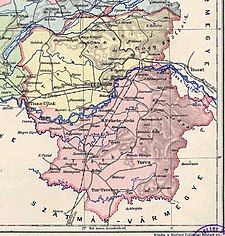
Hont County was an administrative county (comitatus) of the Kingdom of Hungary. Most of its territory is now part of Slovakia, while a smaller southern portion is part of Hungary.

Bars was an administrative county (comitatus) of the Kingdom of Hungary. Its territory is now in central and southern Slovakia. Today in Slovakia, Tekov is the informal designation of the corresponding territory.

Nyitra County was an administrative county (comitatus) of the Kingdom of Hungary. Its territory lay in what is now western Slovakia.

Bereg was an administrative county (comitatus) of the Kingdom of Hungary. Its territory is now mostly in western Ukraine and a smaller part in northeastern Hungary. The capital of the county was Beregszász.

Ung County was an administrative county (comitatus) of the Kingdom of Hungary. Its territory is now mostly in western Ukraine, a smaller part in eastern Slovakia, and a very small area in Hungary.

Máramaros County was an administrative county (comitatus) of the Kingdom of Hungary. Its territory is now in north-western Romania and western Ukraine. The capital of the county was Máramarossziget.

Szabolcs was an administrative county (comitatus) of the Kingdom of Hungary. Its territory is now part of Hungary, except for three villages which are in the Zakarpattia Oblast of Ukraine. The capital of the county was Nyíregyháza.

Szatmár County was an administrative county (comitatus) of the Kingdom of Hungary, situated south of the river Tisza. Most of its territory is now divided between Romania and Hungary, while a very small area is part of Ukraine. The capital of the county was Nagykároly.

Szilágy was an administrative county (comitatus) of the Kingdom of Hungary. Its territory is now in north-western Romania. The capital of the county was Zilah.

Csanád was an administrative county (comitatus) of the Kingdom of Hungary. Its territory is now part of Hungary, except for a small area which is part of Romania. The capital of the county was Makó.

Beszterce-Naszód was an administrative county (comitatus) of the Kingdom of Hungary. Its territory is now in northern Romania. The capital of the county was Beszterce.

Csík was an administrative county (comitatus) of the Kingdom of Hungary. Its territory is now in central Romania. The capital of the county was Csíkszereda.

Háromszék was an administrative county (comitatus) of the Kingdom of Hungary. Situated in south-eastern Transylvania, its territory is now in central Romania. The capital of the county was Sepsiszentgyörgy.

Kis-Küküllő was an administrative county (comitatus) of the Kingdom of Hungary. Its territory is now in central Romania. Kis-Küküllő is the Hungarian name for the river Târnava Mică. The capital of the county was Dicsőszentmárton.

Kolozs County was an administrative county (comitatus) of the Kingdom of Hungary, of the Eastern Hungarian Kingdom and of the Principality of Transylvania. Its territory is now in north-western Romania. The capital of the county was Kolozsvár.

Szolnok-Doboka was an administrative county (comitatus) of the Kingdom of Hungary. Its territory is now in northern Romania. The capital of the county was Dés.

Udvarhely was an administrative county (comitatus) of the Kingdom of Hungary. Its territory is now in central Romania. The capital of the county was Székelyudvarhely.

Gömör-Kishont was an administrative county (comitatus) of the Kingdom of Hungary. Its capital was Rimaszombat. Most of its territory is now part of Slovakia, while a smaller part belongs to Hungary.

Northern Maramureș is a geographic-historical region comprising roughly the eastern half of the Zakarpattia Oblast in southwestern Ukraine, near the border with Romania. Until 1920, it was part of the Maramureș subregion of Transylvania, at which time the former Máramaros County was divided into a northern part, and a southern part.

Nógrád was an administrative county of the Kingdom of Hungary. Its territory is now divided between Hungary and Slovakia. The name Novohrad is still used in Slovakia as an informal designation of the corresponding territory. The name is derived from the former Nógrád castle in Hungary.

























